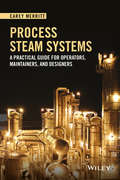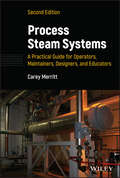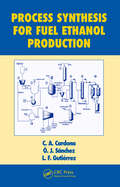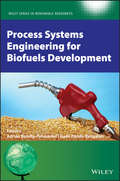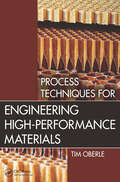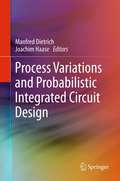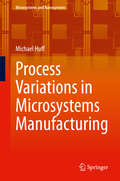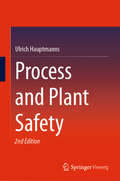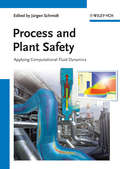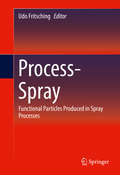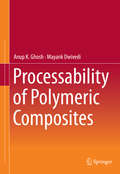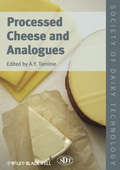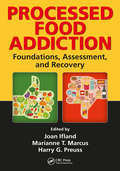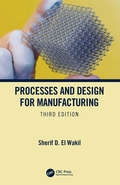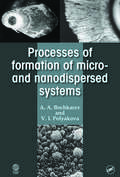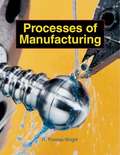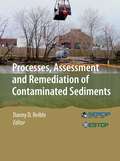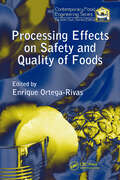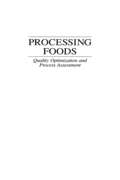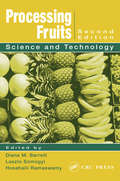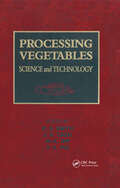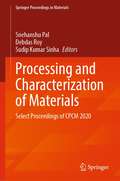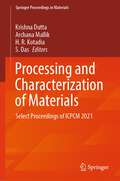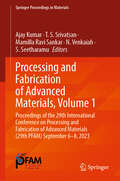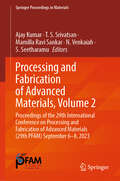- Table View
- List View
Process Steam Systems
by Carey MerrittComprehensively describes the equipment used in process steam systems, good operational and maintenance practices, and techniques used to troubleshoot system problems Explains how an entire steam system should be properly designed, operated and maintained Includes chapters on commissioning and troubleshooting various process systems and problems Presents basic thermodynamics and heat transfer principles as they apply to good process steam system design Covers Steam System Efficiency Upgrades; useful for operations and maintenance personnel responsible for modifying their systems sioning and Troubleshooting the Water Treatment Equipment
Process Steam Systems: A Practical Guide for Operators, Maintainers, Designers, and Educators
by Carey MerrittProcess Steam Systems A comprehensive and accessible handbook for process steam systems The revised second edition of Process Steam Systems: A Practical Guide for Operators, Maintainers, Designers, and Educators delivers a practical guide to ensuring steam systems are properly and efficiently designed, operated, and maintained. The book provides comprehensive information designed to improve process steam system knowledge, reliability, and integration into current manufacturing processes. The most up-to-date version of this volume includes brand-new coverage of current codes, sustainability measures, and updated applications. Heat transfer theory and thermodynamics are tied into practical applications with new practice problems ideal for both professionals seeking to improve their skills and engineers-in training. Readers will also find: Thorough design criteria for process steam systems, complete with detailed illustrations for piping and controls An entirely new chapter on the history of steam systems, including the evolution of the ASME code and boiler accidents Revised coverage of current NFPA, ASME, CSD-1, FM, and building codes, as well as new insurance requirements relevant to practitioners in the industry Expansive design guidance for steam system efficiency upgrades Perfect for operations and maintenance staff at manufacturing, healthcare, and commercial laundries, Process Steam Systems: A Practical Guide for Operators, Maintainers, Designers, and Educators will also earn a place in the libraries of consulting engineers and engineering students with an interest in process manufacturing.
Process Synthesis for Fuel Ethanol Production (Biotechnology and Bioprocessing)
by C.A. Cardona O.J. Sanchez L.F. GutierrezThis book is a comprehensive guide to the design and analysis of the most advanced technologies for fuel ethanol production from feedstocks. It describes how process systems engineering can be applied to fuel ethanol production to achieve new levels of efficiency according to technical, economic, and environmental criteria. The authors cover liquid biofuels; various types of feedstocks, including sugars, starchy crops, lignocellulosic biomass, and microorganisms; and hydrolysis technologies, such as saccharification. They also address new technological innovations based on process integration to reduce energy consumption and the environmental issues of bioethanol production.
Process Systems Engineering for Biofuels Development (Wiley Series in Renewable Resource)
by Christian V. StevensA comprehensive overview of current developments and applications in biofuels production Process Systems Engineering for Biofuels Development brings together the latest and most cutting-edge research on the production of biofuels. As the first book specifically devoted to process systems engineering for the production of biofuels, Process Systems Engineering for Biofuels Development covers theoretical, computational and experimental issues in biofuels process engineering. Written for researchers and postgraduate students working on biomass conversion and sustainable process design, as well as industrial practitioners and engineers involved in process design, modeling and optimization, this book is an indispensable guide to the newest developments in areas including: Enzyme-catalyzed biodiesel production Process analysis of biodiesel production (including kinetic modeling, simulation and optimization) The use of ultrasonification in biodiesel production Thermochemical processes for biomass transformation to biofuels Production of alternative biofuels In addition to the comprehensive overview of the subject of biofuels found in the Introduction of the book, the authors of various chapters have provided extensive discussions of the production and separation of biofuels via novel applications and techniques.
Process Techniques for Engineering High-Performance Materials
by Tim OberleMost processed materials retain a memory of their production process at the molecular level. Subtle changes in production-such as variations in temperature or the presence of impurities-can impart performance benefits or drawbacks to individual batches of products. Some product developers have taken advantage of this process dependency to tailor pr
Process Variations and Probabilistic Integrated Circuit Design
by Joachim Haase Manfred DietrichUncertainty in key parameters within a chip and between different chips in the deep sub micron area plays a more and more important role. As a result, manufacturing process spreads need to be considered during the design process. Quantitative methodology is needed to ensure faultless functionality, despite existing process variations within given bounds, during product development. This book presents the technological, physical, and mathematical fundamentals for a design paradigm shift, from a deterministic process to a probability-orientated design process for microelectronic circuits. Readers will learn to evaluate the different sources of variations in the design flow in order to establish different design variants, while applying appropriate methods and tools to evaluate and optimize their design.
Process Variations in Microsystems Manufacturing (Microsystems and Nanosystems)
by Michael HuffThis book thoroughly examines and explains the basic processing steps used in MEMS fabrication (both integrated circuit and specialized micro machining processing steps. The book places an emphasis on the process variations in the device dimensions resulting from these commonly used processing steps. This will be followed by coverage of commonly used metrology methods, process integration and variations in material properties, device parameter variations, quality assurance and control methods, and design methods for handling process variations. A detailed analysis of future methods for improved microsystems manufacturing is also included. This book is a valuable resource for practitioners, researchers and engineers working in the field as well as students at either the undergraduate or graduate level.
Process and Plant Safety
by Ulrich HauptmannsAccidents in industrial installations are random events. Hence they cannot be totally avoided. Only the probability of their occurrence may be reduced and their consequences be mitigated. The book proceeds from hazards caused by materials and process conditions to indicating engineered and organizational measures for achieving the objectives of reduction and mitigation. Qualitative methods for identifying weaknesses of design and increasing safety as well as models for assessing accident consequences are presented. The quantitative assessment of the effectiveness of safety measures is explained. The treatment of uncertainties plays a role there. They stem from the random character of the accident and from lacks of knowledge of some of the phenomena to be addressed. The reader is acquainted with the simulation of accidents, with safety and risk analyses and learns how to judge the potential and limitations of mathematical modelling. Risk analysis is applied amongst others to “functional safety” and the determination of “appropriate distances” between industry and residential areas (land-use planning). This shows how it can be used as a basis for safety-relevant decisions. Numerous worked-out examples and case studies addressing real plants and situations deepen the understanding of the subjects treated and support self-study.
Process and Plant Safety: Applying Computational Fluid Dynamics
by Jürgen SchmidtThe safe operation of plants is of paramount importance in the chemical, petrochemical and pharmaceutical industries. Best practice in process and plant safety allows both the prevention of hazards and the mitigation of consequences. Safety Technology is continuously advancing to new levels and Computational Fluid Dynamics (CFD) is already successfully established as a tool to ensure the safe operation of industrial plants. With CFD tools, a great amount of knowledge can be gained as both the necessary safety measures and the economic operation of plants can be simultaneously determined. Young academics, safety experts and safety managers in all parts of the industry will henceforth be forced to responsibly judge these new results from a safety perspective. This is the main challenge for the future of safety technology. This book serves as a guide to elaborating and determining the principles, assumptions, strengths, limitations and application areas of utilizing CFD in process and plant safety, and safety management. The book offers recommendations relating to guidelines, procedures, frameworks and technology for creating a higher level of safety for chemical and petrochemical plants. It includes modeling aids and concrete examples of industrial safety measures for hazard prevention.
Process-Spray
by Udo FritschingThis book describes the latest research on producing functional particles using spray processes. The authors detail micro level elementary processes and phase boundaries, process analysis scaling and modeling, and macro level process functions and particle properties. They include numerical simulations and particulars of experiments for deriving process conditions for particle production.
Processability of Polymeric Composites
by Anup K. Ghosh Mayank DwivediThis textbook covers the processing of advanced composites and their various technologies, with special emphasis on the distinct characteristics of processability. The book covers the impact of different processing techniques on the performance and characteristics of the final product. Written with a didactic approach, the volume contains extensive illustrations and pedagogic features (including examples and exercises) to help the reader assess and correlate existing technologies. The book will be useful as a text in graduate courses in processing of polymers and composites and can additionally be used as a professional reference.
Processed Cheese and Analogues (Society of Dairy Technology #16)
by Adnan Y. TamimePart of the Society of Dairy Technology Series, this book deals with a commercially significant sector of dairy science. The book includes chapters on legislation, functionality of ingredients, processing plants and equipment, manufacturing best practice, packaging, and quality control. The chapters are authored by an international team of experts. This book is an essential resource for manufacturers and users of processed and analogue cheese products internationally; dairy scientists in industry and research; and advanced food science students with an interest in dairy science.
Processed Food Addiction: Foundations, Assessment, and Recovery
by Harry G. Preuss Joan Ifland Marianne T. MarcusObesity and eating disorders have stubbornly refused to respond to treatment since the 1990’s. This book organizes the evidence for a possible answer, i.e., that the problem could be one of addiction to processed foods. In a Processed Food Addiction (PFA) model, concepts of abstinence, cue-avoidance, acceptance of lapses, and consequences all play a role in long-term recovery. Application of these concepts could provide new tools to health professionals and significantly improve outcomes. This book describes PFA recovery concepts in detail. The material bridges the research into practical steps that health professionals can employ in their practices. It contains an evidence-based chapter on concepts of abstinence from processed foods. It rigorously describes PFA pathology according to the DSM 5 Addiction Diagnostic Criteria. It applies the Addiction Severity Index to PFA so that health practitioners can orient themselves to diagnosing and assessing PFA. It contains ground-breaking insight into how to approach PFA in children. Because the book is evidence-based, practitioners can gain the confidence to put the controversy about food addiction to rest. Practitioners can begin to identify and effectively help their clients who are addicted to processed foods. This is a breakthrough volume in a field that could benefit from new approaches.
Processes and Design for Manufacturing, Third Edition
by Sherif D. El WakilProcesses and Design for Manufacturing, Third Edition, examines manufacturing processes from the viewpoint of the product designer, investigating the selection of manufacturing methods in the early phases of design and how this affects the constructional features of a product. The stages from design process to product development are examined, integrating an evaluation of cost factors. The text emphasizes both a general design orientation and a systems approach and covers topics such as additive manufacturing, concurrent engineering, polymeric and composite materials, cost estimation, design for assembly, and environmental factors. Appendices with materials engineering data are also included.
Processes of Formation of Micro -and Nanodispersed Systems
by A. A. Bochkarev V. I. PolyakovaProcesses of Formation of Micro- and Nanodispersed Systems is a comprehensive analysis and presentation of the physical processes and phenomena that lead to the formation of disperse materials. It also details the properties of disperse materials yielded from various processes.Special attention is given to the homogeneous condensation of metal vapo
Processes of Manufacturing
by R. Thomas WrightProcesses of Manufacturing provides comprehensive instruction in the various methods of processing metals, plastics, ceramics, and composite materials. The book devotes several chapters each to the major processes used in manufacturing today: casting and molding, forming, separating,conditioning, assembling, and finishing. A final section provides students with an introduction to such process design and control topics as sequencing of operations, automating processes, and quality control. The book is extensively illustrated with photos and a large number of line drawings that clearly convey the details of important processes.
Processes, Assessment and Remediation of Contaminated Sediments
by Danny D. ReibleThe purpose of this book is to help engineers and scientists better understand contaminated sediment sites and identify and design remedial approaches that are more efficient and effective. Contaminated sediment management is a difficult and costly exercise that is rarely addressed with easily identified and implemented remedies. It is hoped that this book can help identify and implement management approaches that provide an optimal, if not entirely satisfactory, solution to sediment contaminant problems.
Processing Effects on Safety and Quality of Foods
by Enrique Ortega-RivasCovers a Host of Groundbreaking TechniquesThermal processing is known to effectively control microbial populations in food, but the procedure also has a downsideit can break down the biochemical composition of foods, resulting in a marked loss of sensory and nutritional quality. Processing Effects on Safety and Quality of Foods delineates three dec
Processing Foods: Quality Optimization and Process Assessment
by Fernanda A.R. Oliveira Jorge C. OliveiraProcessing Foods: Quality Optimization and Process Assessment provides a large body of updated information - helping researchers and industrialists make use of new concepts, technologies and approaches that are at the heart of modern food research. It will be a useful tool in the interweaving of scientific and technological information that the mul
Processing Fruits: Science and Technology, Second Edition
by Diane M. Barrett Laszlo Somogyi Hosahalli RamaswamyThe new edition of this highly acclaimed reference provides comprehensive and current information on a wide variety of fruits and processes. Revised and updated by an international team of contributors, the second edition includes the latest advances in processing technology, scientific research, and regulatory requirements. Expanded coverage includes fresh-cut fruits, non-thermal methods of fruit processing, and more information on the effects of variety and maturity on processed product quality. It presents a wide range of information on fruits and fruit products and covers traditional as well as the newest technologies.
Processing Vegetables: Science and Technology (Food Science And Technology Ser.)
by Y. H. Hui Wai-Kit Nip Durward S. Smith Jerry N. CashThe variety, distribution range and quality of processed vegetables have grown rapidly in recent years, due in large part to advances in vegetable processing technology. This 448-page book provides a detailed, expert guide to current methods of vegetable processing. The authoritative presentations were prepared by a team of leading international food specialists. The text is organized for easy reference and supplemented with hundreds of photographs and diagrams illustrating procedures and equipment. Hundreds of tables provide useful reference data in convenient form. Each chapter includes a section of extensive references for additional research on each subject.
Processing and Characterization of Materials: Select Proceedings of CPCM 2020 (Springer Proceedings in Materials #13)
by Snehanshu Pal Debdas Roy Sudip Kumar SinhaThis book includes selected conference proceedings of Conference on Processing and Characterization of Materials (CPCM-2020). The content of the book includes processing of and characterization of materials, sustainable energy materials, defense materials, functionally graded materials, and composites which has significant impact on cutting-edge applications. The book also includes surface engineering, computational methods and materials, waste utilization, and corrosion and environmental degradation of materials. Design, research, and development studies, experimental investigations, theoretical analysis, and fabrication techniques relevant to the application of materials in various assemblies, ranging from individual components to complete structure are presented in the book. The book is useful for graduate students, researchers, and industry professionals alike.
Processing and Characterization of Materials: Select Proceedings of ICPCM 2021 (Springer Proceedings in Materials #26)
by Krishna Dutta S. Das Archana Mallik H. R. KotadiaThis book presents select proceedings of the International Conference on Processing and Characterization of Materials (ICPCM 2021) organized by the Department of Metallurgical and Materials Engineering, National Institute of Technology, Rourkela. Various topics covered in this book include materials processing, materials characterization, mineral concentration, metal extraction and refining, surface engineering, thin films and coatings, materials for nuclear, aviation and defence applications, advanced and smart materials, composites, mechanical behaviour, modelling and simulation, materials for energy applications and corrosion and environmental degradation. This book is of interest to researchers and professionals working in the different areas of material science.
Processing and Fabrication of Advanced Materials, Volume 1: Proceedings of the 29th International Conference on Processing and Fabrication of Advanced Materials (29th PFAM) September 6–8, 2023 (Springer Proceedings in Materials #52)
by T. S. Srivatsan Ajay Kumar S. Seetharamu Mamilla Ravi Sankar N. VenkaiahThis book presents select proceedings of the International Conference on Processing and Fabrication of Advanced Materials (PFAM 2023). It covers the latest research in the areas of processing, fabrication, characterization and evaluation of traditional, advanced and emerging materials. The topics covered include various properties and performance attributes of modern-age materials. It further covers their applications in areas such as aerospace and other space-related industries, automobile, marine and defense, biomedical and healthcare, electronics and communications, energy storage/harvesting, heavy equipment, machinery and goods and semiconductor materials manufacturing. The book is a valuable reference for researchers and professionals interested in processing and fabrication of advanced materials and allied fields.
Processing and Fabrication of Advanced Materials, Volume 2: Proceedings of the 29th International Conference on Processing and Fabrication of Advanced Materials (29th PFAM) September 6–8, 2023 (Springer Proceedings in Materials #53)
by T. S. Srivatsan Ajay Kumar S. Seetharamu Mamilla Ravi Sankar N. VenkaiahThis book presents select proceedings of the International Conference on Processing and Fabrication of Advanced Materials (PFAM 2023). It covers the latest research in the areas of processing, fabrication, characterization, and evaluation of traditional, advanced, and emerging materials. The topics covered include various properties and performance attributes of modern-age materials. It further covers their applications in areas such as aerospace and other space-related industries, automobile, marine and defense, biomedical and healthcare, electronics and communications, energy storage/harvesting, heavy equipment, machinery and goods, and semiconductor materials manufacturing. The book is a valuable reference for researchers and professionals interested in processing and fabrication of advanced materials and allied fields.
